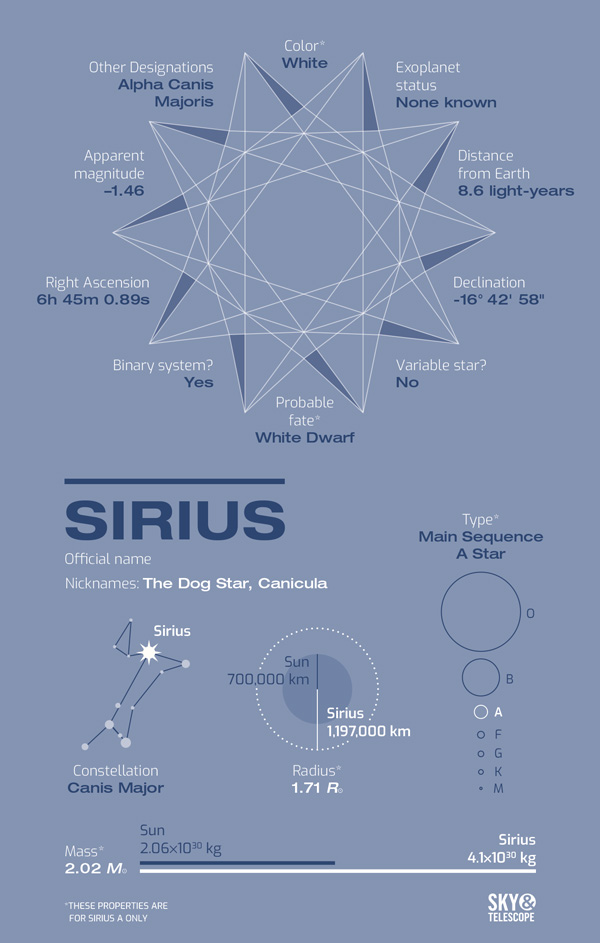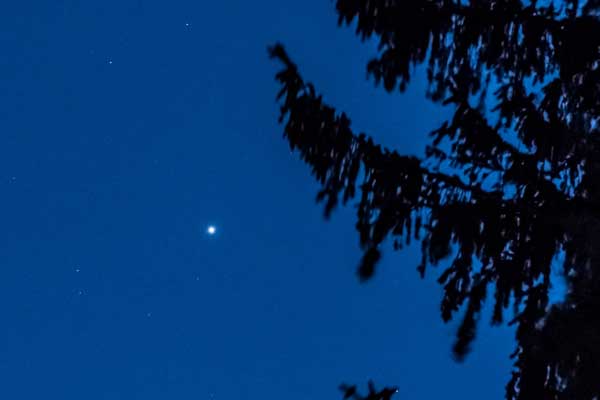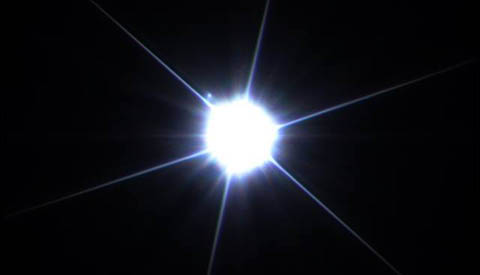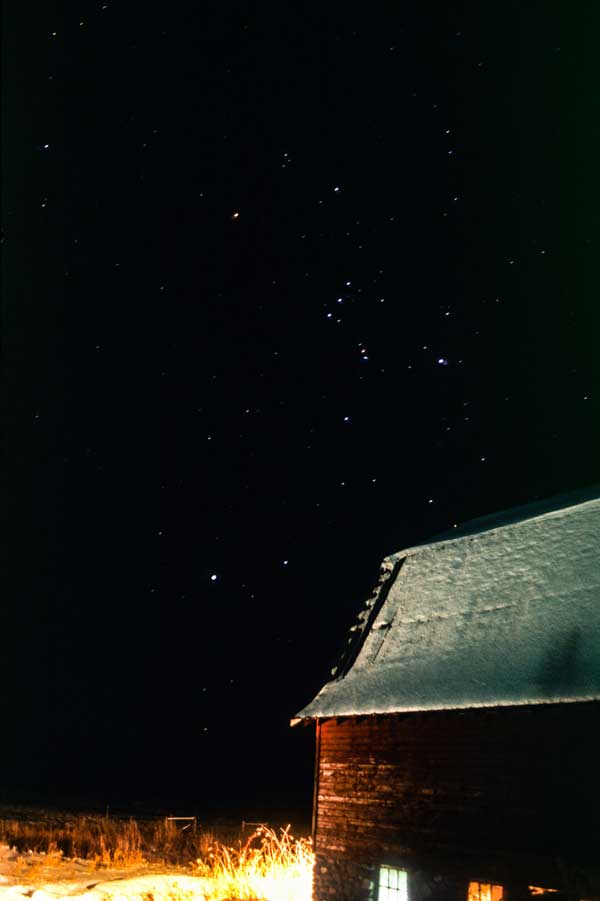Sirius Vitals

Physical Characteristics

Daniel Johnson
People always want to know what mountain, sea, or canyon is the tallest, deepest, or widest. And when it comes to the night sky, people always want to know what objects are the brightest. For those stars visible from Earth, that is brilliant Sirius.
To be sure, this star isn't the brightest astronomical object visible from Earth, an important distinction. Besides the Sun and Moon (which obviously shine many magnitudes brighter), the planets Venus and Jupiter also appear more radiant. So do Mercury and Mars, depending on their positions in their orbits relative to Earth. But of all the true stars (not including the Sun), Sirius stands alone as the most brilliant by a wide margin — it’s about twice the apparent brightness of the next brightest star, Canopus.
As an A-class star, Sirius is significantly larger than our Sun and shines with an absolute magnitude more than 20 times more luminous. But it’s still on the main sequence, which means it’s still burning hydrogen in its core — it hasn’t expanded into a giant phase yet. So the primary reason for the star’s impressive appearance from Earth is because it’s close. At a distance of only 8.6 light-years away, Sirius is practically an astronomical stone’s throw away. There are a few stars that are closer to us, including the familiar Alpha Centauri system and a handful of red dwarfs, but none of them are a match for Sirius’s absolute magnitude and that makes the difference.
Unlike our Sun, Sirius isn’t alone. It’s a member of a binary system, and its companion is a tiny (smaller than Earth!) white dwarf star named Sirius B, or more playfully, “The Pup.” Though it has about the Sun’s mass, the Pup has shrunk to less than the size of Earth, making it an incredibly dense object. It exerts a powerful gravitational pull; in fact, it was by observing the back-and-forth motions of Sirius A that astronomers first suspected (back in 1844!) that there was another star nearby. Sirius B is dim and faint compared to its companion, and was only discovered in 1862.

Gabriela and Fabio Carvalho
Origin / Mythology
Because of its brightness, it's no surprise that Sirius has been of significance to many people throughout history. In some ancient cultures, including the Greeks from whom we inherit much of our astronomical tradition, the constellation Orion represented a hunter, accompanied through the sky by his canine companion, Canis Major (where Sirius is the brightest star). Many cultures associated the star with dogs.
In ancient Egypt, the brightest star was connected with several mythological figures, including Isis, Osiris, and Anubis, and the timing of its heliacal rising was used as a seasonal sign, warning farmers of the Nile’s annual flooding. Closer to home, the modern phrase “dog days of summer” comes to us through the Greeks who (erroneously) assumed that the star's heat contributed to the warmth of the summer months.
How to See Sirius
Sirius is located in a rather small constellation, Canis Major. It's visible in evening skies in late winter; in late summer, you'll find it in the east in the pre-dawn hours.
One easy way to find Sirius in winter evening skies is to locate Orion, which dominates this region of sky. The bright star is a short distance southeast of Orion; in fact, the three stars of Orion’s belt can be used as a “pointer” to Sirius.
When beginner astronomers are just starting out, they may have trouble distinguishing planets from bright stars. To help with this, remember the popular rule-of-thumb: “Planets don’t twinkle, just the stars.” This isn’t 100% accurate, because planets may twinkle if the atmosphere is very turbulent, but it’s a good starting place. Sirius is well known for its intense twinkling, with rapid fluctuations in brightness and color. It’s fun to watch, so enjoy the sight!
A note to small-telescope owners: Don’t expect to see the Pup! The faint white dwarf is notoriously difficult to spot, partly because of its companion's glare. You’ll need a very large scope and excellent seeing conditions to have a shot at nabbing Sirius B.
If you’ve got the optics and are up for the challenge, see S&T contributing editor Bob King’s guidance on seeing the Pup.
 6
6










Comments
Thomas-Harrison
March 28, 2018 at 4:23 pm
Sirius B does not have twice the Sun's mass, or it would be a neutron star. More like 0.6 to 0.8 times the Sun's mass.
You must be logged in to post a comment.
Monica Young
March 28, 2018 at 4:47 pm
Correct, these values in the table are for Sirius A. I've made this more clear with a footnote for those properties only belonging to Sirius A.
You must be logged in to post a comment.
DukeBriscoe
March 31, 2018 at 8:57 pm
Thanks for clarifying the table, but the text of the article still says "Though it has twice the Sun’s mass, the Pup has shrunk to less than the size of Earth".
You must be logged in to post a comment.
Monica Young
April 2, 2018 at 9:39 am
Ah, I'm sorry I missed this mistake. Sirius B has about the Sun's mass, and I've corrected this statement in the article.
You must be logged in to post a comment.
bwana
March 30, 2018 at 9:39 pm
Now you given me a challenge; split Sirius and its twin!
bwa
You must be logged in to post a comment.
AlphaCentauri
March 9, 2019 at 6:41 pm
I wonder if a 127mm Mak-Cass telescope and a 7mm or 9mm eyepiece will show the Pup? I'm gonna give it a shot, if the clouds get out of the way before Sirius gets too low in the sky. It's been a cloudy winter here in WV.
You must be logged in to post a comment.
You must be logged in to post a comment.